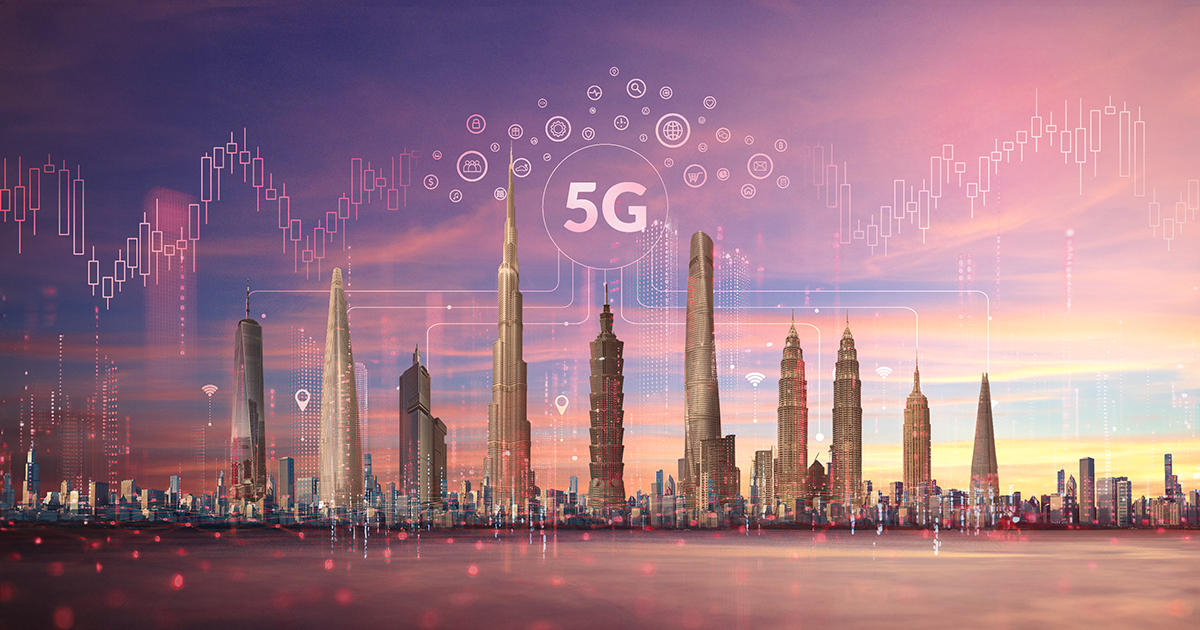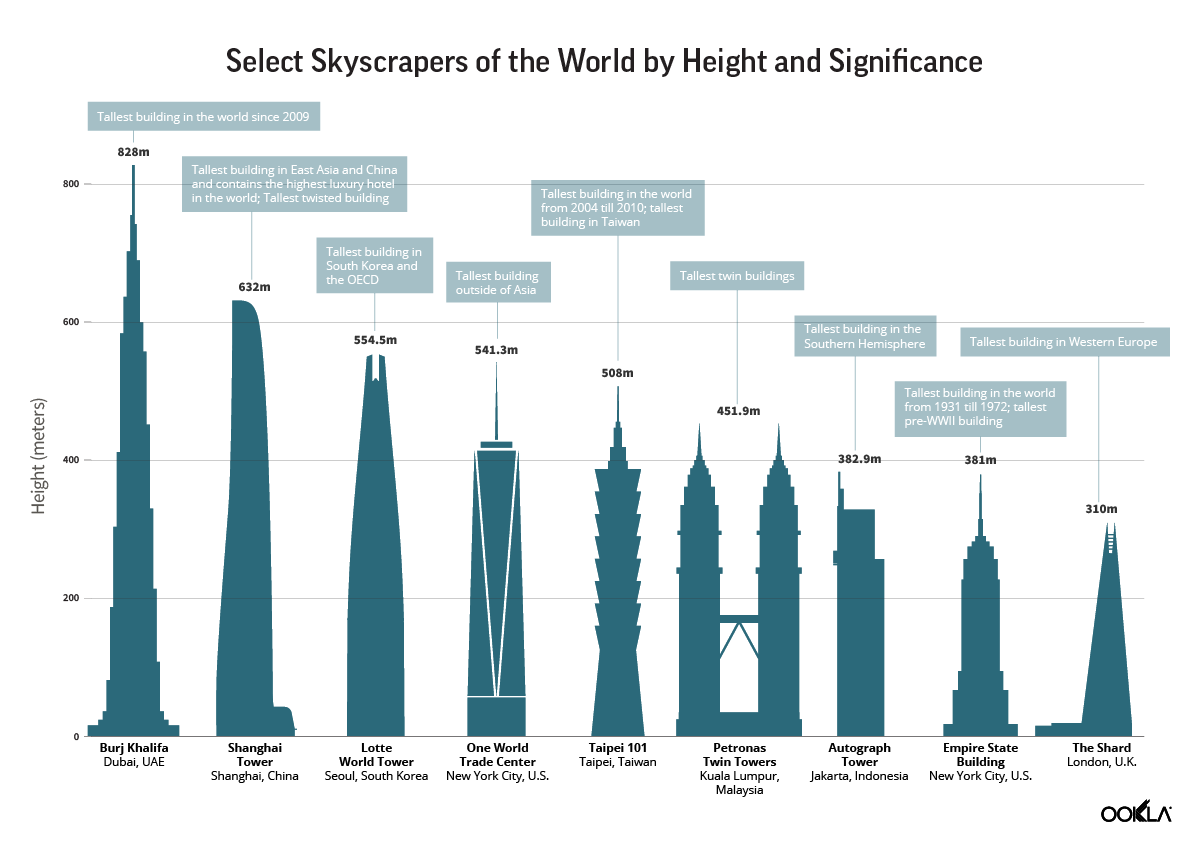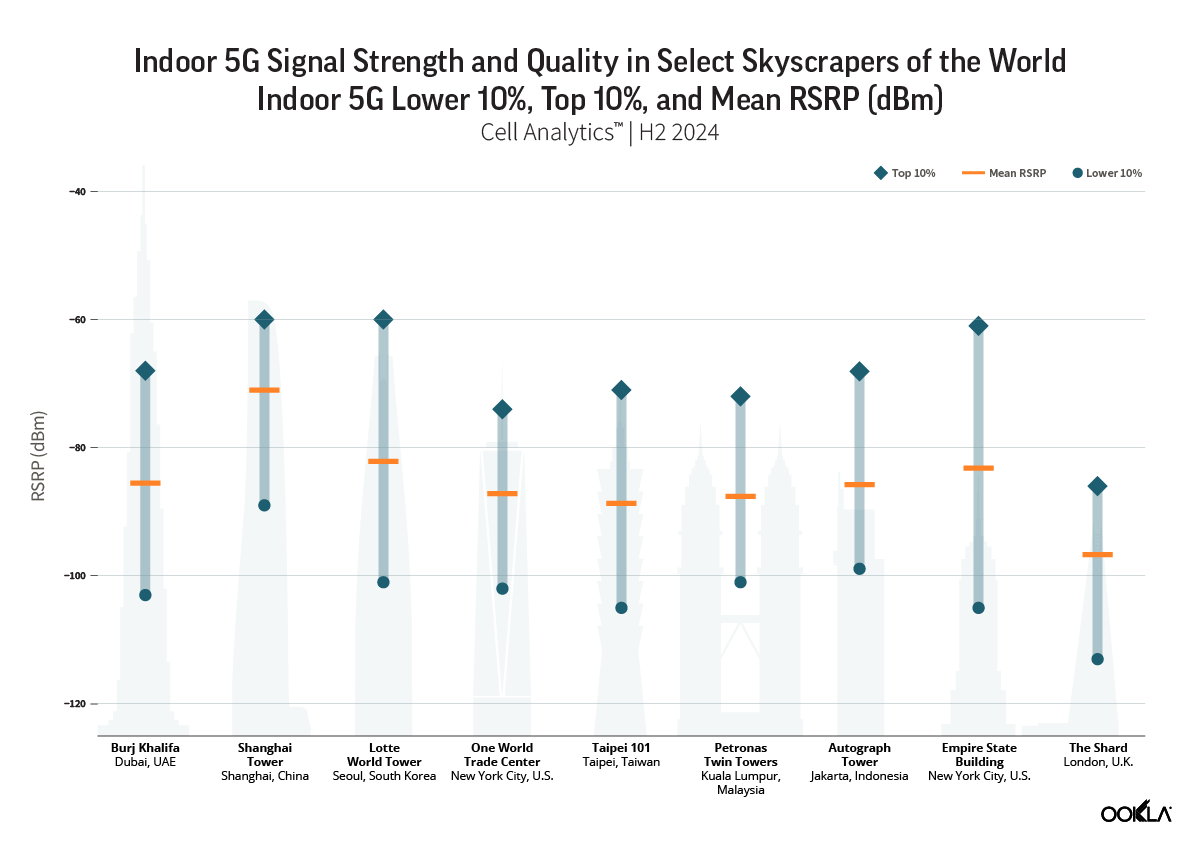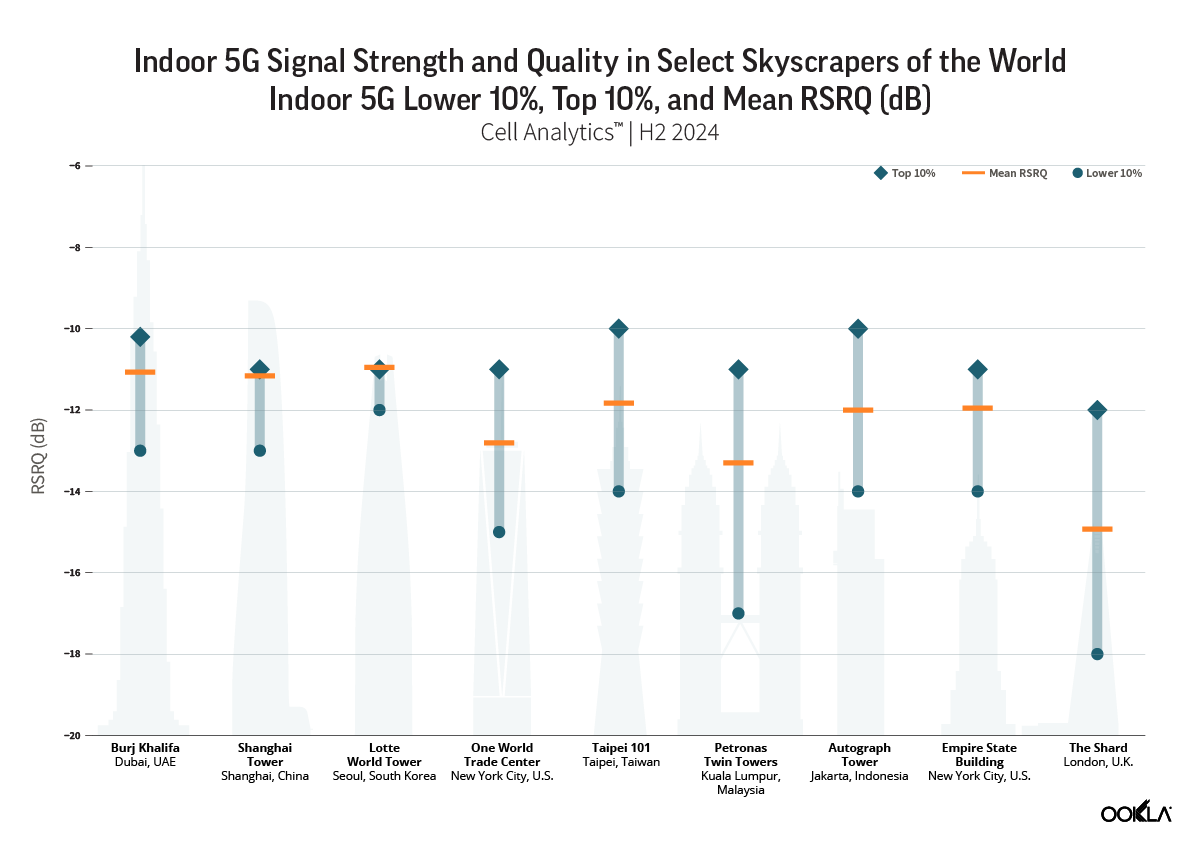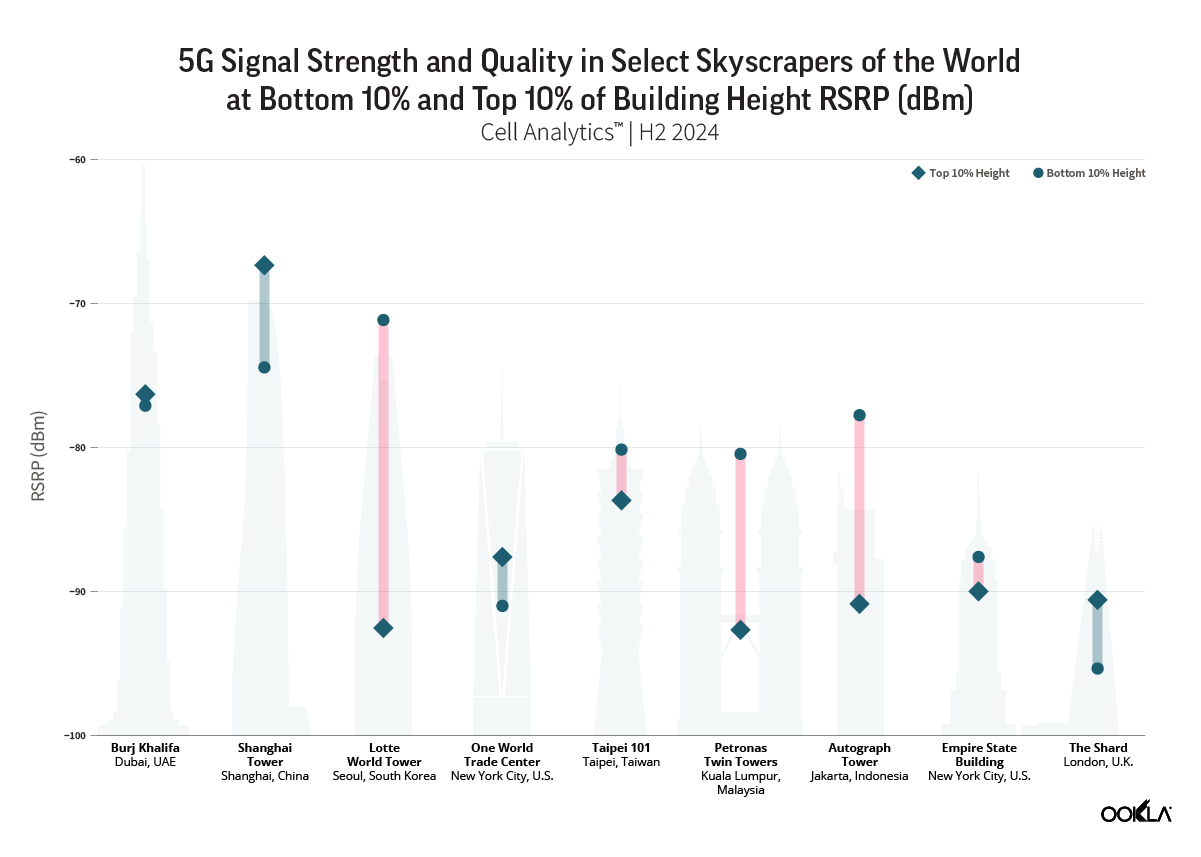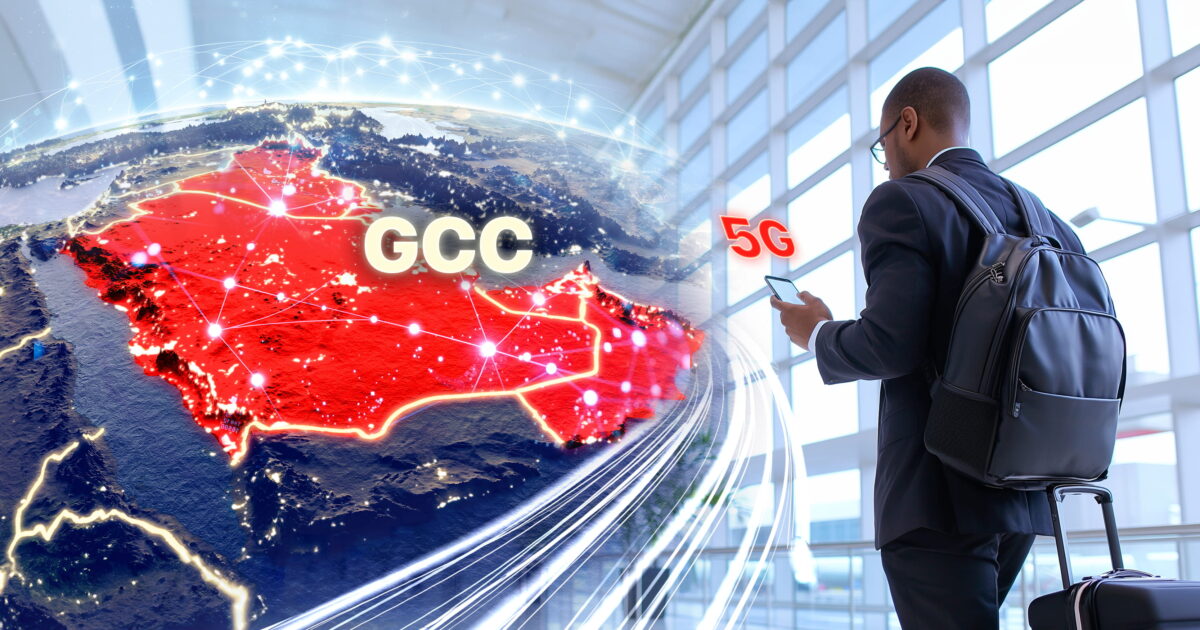Skyscrapers are not just architectural achievements; they also test the limits of telecommunications and connectivity systems. These structures highlight both the obstacles and innovations required for seamless connectivity in high-rise environments. This report, using data from Cell Analytics™, benchmarks the 5G indoor coverage experience in nine of the world’s most iconic buildings by analyzing the average Reference Signal Received Power (RSRP) and Reference Signal Received Quality (RSRQ), providing critical insights into the signal strength and quality that subscribers experience within these architectural marvels.
Icons That Shape Skylines
Modern skyscrapers are more than just towering structures—they shape city skylines, serve as commercial and cultural hubs, and play a crucial role in defining a nation’s global presence. Their impact also goes beyond aesthetics. They contribute significantly to a city’s economy by attracting businesses, investors, and tourists. For example, the Burj Khalifa in Dubai has helped position the city as a global business and tourism hub, drawing millions of visitors each year. Similarly, the Empire State Building in New York remains a historic landmark and one of the most visited tourist attractions in the world.
Using Ookla® Cell Analytics™ data, we analyzed nine of the most iconic buildings in the world, recognized for their unique architectural designs, global influence, and economic and cultural significance.
Most skyscrapers provide strong signal strength but coverage gaps still exist
Drilling down into data at the individual building from the second half of 2024, we evaluated subscribers’ 5G indoor experience by measuring the average Reference Signal Received Power (RSRP) and Reference Signal Received Quality (RSRQ). RSRP represents the network signal strength received by a mobile phone. An RSRP value that exceeds -90 dBm indicates superior coverage. If the signal strength is between -90 dBm and -100 dBm, then network coverage is considered good. Below this range, expect slower download speeds and potential network disconnections. RSRQ is a metric used to evaluate the quality of the reference signal received by a device. A value of -10 dB or higher indicates excellent network quality while a value between -10 dB and -15 dB is considered good. An RSRQ value lower than -15 dB is poor or indicates no signal at all.
Overall, the 5G indoor coverage across the nine skyscrapers reveals that most buildings provide superior 5G signal strength, as well as excellent network quality. However, some still face challenges in ensuring consistent connectivity. Shanghai Tower recorded the strongest 5G signal among all buildings, with a weighted average RSRP of -71.04 dBm of all samples detected inside the building. This suggests a well-optimized indoor network, likely supported by China’s extensive 5G infrastructure. As China is one of the major leaders in 5G deployment, major urban centers like Shanghai benefit from advanced indoor network solutions, such as small cells and distributed antenna systems (DAS), ensuring strong coverage even in high-rise environments.
Burj Khalifa in UAE, and the Empire State Building New York City, showed strong 5G coverage, with average RSRP values of -85.53 dBm and -83.19 dBm, respectively. Both buildings also reported very good signal quality, with an average RSRQ of -11.07 dB and -11.95 dB respectively. The Empire State Building, completed in 1931, has undergone modernization efforts to enhance its telecommunications infrastructure. Similarly, the Burj Khalifa benefits from Dubai’s extensive 5G rollout, with the UAE ranking among the top countries in 5G performance.
The Shard in London reported the weakest 5G coverage among the selected buildings, with an average RSRP of -96.69 dBm. The Shard’s glass-heavy design may contribute to this weaker performance, as glass can reflect and absorb mobile signals. The building also reported a much weaker signal strength in the lower 10% with RSRP value of -113 dBM, indicating that in certain areas of the building, users are experiencing poor 5G coverage and quality.
Taipei 101 and the Petronas Twin Towers in Kuala Lumpur, showed good average 5G RSRP but experienced weaker signals in certain areas. The lower 10% RSRP values for both buildings were below -100 dBm (-105.00 dBm for Taipei 101 and -101.00 dBm for Petronas Twin Towers), suggesting that parts of these buildings may suffer from inconsistent coverage. Taipei 101 was designed to withstand earthquakes and typhoons, incorporating thick concrete and reinforced steel, which can interfere with mobile signals. While the Petronas Twin Towers currently lack a dedicated indoor 5G coverage solution.
One World Trade Center in New York City and Autograph Tower in Jakarta had similar 5G characteristics, with very good average RSRP around -85 dBm or better, but the reported lower 10% values suggest potential dead zones or weaker coverage in some areas.
From lobby to observation deck
Using Cell Analytics data, we compared the 5G the average RSRP and RSRQ at two different height levels in each skyscraper: Bottom 10% of the building height, which represents coverage on the lower floors, based on samples collected closest to the ground floor, and Top 10% of the building height, which represents the highest levels, based on samples collected at the floors nearest to the top of the building.
Several skyscrapers showed minimal differences in 5G signal strength and quality between the lowest and highest floors. Burj Khalifa, One World Trade Center, Taipei 101, and the Empire State Building all had RSRP variations of 3 dBm or less between measurements taken at the bottom and top levels. The Burj Khalifa, the tallest building in the world at 828 meters, reported a slight improvement from -77.09 dBm at the lower floors to -76.30 dBm at the top.
Burj Khalifa, Taipei 101, and the Empire State Building also reported consistent 5G RSRQ between their lower and top floors, indicating stable 5G network quality. All four buildings have high-altitude observation decks, where strong 5G coverage is essential for tourists, businesses, and building operations.
In contrast, some skyscrapers exhibited noticeably larger differences between the lower and top floors RSRP and RSRQ, with weaker 5G signals at their higher levels. Petronas Twin Towers, Lotte World Tower, and Autograph Tower all showed a significant decline in signal strength as elevation increased. Petronas Twin Towers recorded a relatively strong -80.44 dBm at nearer to ground levels, but this dropped to -92.67 dBm at the top. This is mainly due to the lack of a dedicated indoor 5G coverage solution, with most 5G signals coming from outdoor cell towers. Similarly, the RSRP at Lotte World Tower fell from -71.14 dBm at the lower floors to -92.54 dBm for samples at the highest point. This suggests that while the lower sections of these buildings benefit from stronger 5G coverage, the network infrastructure at the upper floors may not be as robust.
Reliable 5G coverage in skyscrapers requires targeted network solutions
Skyscrapers play a key role in modern cities as business hubs, residential spaces, and major tourist attractions, making strong indoor 5G coverage essential. Tourists visiting observation decks, businesses operating in high-rise offices, and residents in skyscraper apartments all require seamless connectivity for work, communication, and entertainment. However, the primary challenge lies in delivering consistent performance and quality across various indoor settings, where issues may be confined to certain floors or sections. Modern building materials, such as low-emissivity (Low-E) glass, can significantly impact 5G signal attenuation by blocking or reflecting radio frequencies, especially in high-frequency bands like mmWave.
These challenges highlight the need for dedicated indoor solutions such as small cell deployments, distributed antenna systems (DAS), and enhanced in-building network infrastructure. An alternative to deploying in-building 5G systems is to selectively offload usage to Wi-Fi provided these systems are designed, optimized, and operated to deliver an equivalent quality of experience – this can be done using Ekahau.
As 5G continues to evolve, telecom providers and building developers must work together to improve indoor network quality, ensuring that users at all levels of a skyscraper experience fast, stable, and uninterrupted connectivity. For operators, 5G indoor deployments are a strategic avenue to monetize their investments through advances such as massive IoT (IoT), enhanced mobile broadband (eMBB), and fixed wireless access (FWA), which will all play an important role in transformation across sectors such as industrial automation, retail applications, and smart cities.
Ookla can assist operators in identifying buildings or indoor venues with coverage or capacity issues using crowdsourced data and diagnosis. Powered by millions of signal measurements collected daily by Speedtest®, Cell Analytics provides intelligence about wireless service quality, RF measurements, data usage, user density, cell site locations, and much more. To find out more about Cell Analytics, please get in touch.
Ookla retains ownership of this article including all of the intellectual property rights, data, content graphs and analysis. This article may not be quoted, reproduced, distributed or published for any commercial purpose without prior consent. Members of the press and others using the findings in this article for non-commercial purposes are welcome to publicly share and link to report information with attribution to Ookla.
